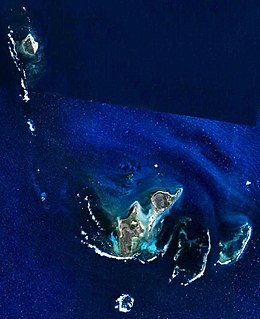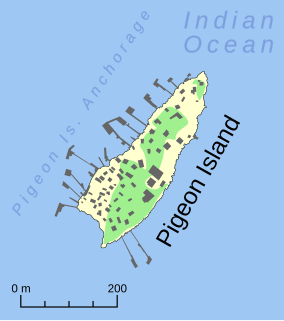
Batavia was a ship of the Dutch East India Company (VOC). Built in Amsterdam in 1628 as the company's new flagship, she sailed that year on her maiden voyage for Batavia, capital of the Dutch East Indies. On 4 June 1629, Batavia was wrecked on the Houtman Abrolhos, a chain of small islands off the western coast of Australia.

The Houtman Abrolhos is a chain of 122 islands, and associated coral reefs, in the Indian Ocean off the west coast of Australia, about eighty kilometres (50 mi) west of Geraldton, Western Australia. It is the southernmost true coral reef in the Indian Ocean, and one of the highest latitude reef systems in the world. It is one of the world's most important seabird breeding sites, and is the centre of Western Australia's largest single-species fishery, the western rock lobster fishery. It has a small seasonal population of fishermen, and a limited number of tourists are permitted for day trips, but most of the land area is off limits as conservation habitat. It is well known as the site of numerous shipwrecks, the most famous being the Dutch ships Batavia, which was wrecked in 1629, and Zeewijk, wrecked in 1727.

The Wallabi Group is the northernmost group of islands in the Houtman Abrolhos off the western coast of Western Australia. it is 58 kilometres from the Australian mainland, and about 9 kilometres from the Easter Group.

The Easter Group is the central of three groups of islands that make up the Houtman Abrolhos island chain. The group measures about 20 kilometres by 12 kilometres, and consists of a number of islands including

The Pelsaert Group is the southernmost of the three groups of islands that make up the Houtman Abrolhos island chain. it consists of a number of islands, the largest of which are Gun Island, Middle Island, and Pelsaert Island. The group is named after a Dutch "opperkoopman" who stranded nearby with the VOC-ship "Batavia" in 1629. The group contains the most southerly true coral reefs in the Indian Ocean. The group is part of the Houtman Abrolhos Important Bird Area, identified as such by BirdLife International because of its importance for supporting large numbers of breeding seabirds.

North Island is the northernmost island in the Houtman Abrolhos, a coral reef archipelago in the Indian Ocean off the coast of Mid West Western Australia. Located about 14 km (9 mi) from the nearest island group, it is one of the largest islands in the Houtman Abrolhos, and one of the few to support dune systems. It has relatively diverse flora dominated by chenopod shrubs and fauna that includes the introduced tammar wallaby, around seven species of reptile, and about 15 resident bird species.

Batavia Road was a passenger boat used from 1946 for commercial tourist operation in the Houtman Abrolhos, a group of islands off the coast of Western Australia.

North East Reef is a reef in the Wallabi Group of the Houtman Abrolhos, in the Indian Ocean off the coast of Western Australia. Located at 28°25′13″S113°48′41″E, it takes its name from the fact that it is situated to the north-east of the main body of islands that makes up the Wallabi Group. The island is part of the Houtman Abrolhos Important Bird Area, identified as such by BirdLife International because of its importance for supporting large numbers of breeding seabirds.

Fish Point is a point in the north-eastern corner of East Wallabi Island in the Houtman Abrolhos island chain off the coast of Western Australia. It is located at 28°25′40″S113°44′34″E. It sits at the foot of Flag Hill, the highest peak on East Wallabi Island, and its western edge looks out onto Turtle Bay.

Gun Island is one of the larger islands in the Pelsaert Group of the Houtman Abrolhos, in the Indian Ocean off the west coast of Australia. It is nominally at 28°53′10″S113°51′35″E, about 4 km (2.5 mi) north and east of Half Moon Reef and is a flat limestone outcrop of about 800 by 420 metres in size. The island is part of the Houtman Abrolhos Important Bird Area, identified as such by BirdLife International because of its importance for supporting large numbers of breeding seabirds.

The Abrolhos painted buttonquail is a subspecies of the painted buttonquail endemic to the Houtman Abrolhos. It is common on North Island, and also occurs on other islands of the Wallabi Group, namely East Wallabi, West Wallabi, Seagull and Pigeon Islands.
In fact the Batavia was wrecked in the Wallabi Group, 60 kilometres (40 mi) to the north. The wreckage seen by the Beagle was either that of the Zeewyk, or the unidentified wreck seen by the Zeewyks crew. The name Batavia Road is thus a misnomer, as are a number of other places named by Stokes, including Pelsaert Island, the Pelsaert Group, and Wreck Point. Stokes' erroneous view was accepted without question for over fifty years, and it has been claimed that the confusion caused the discovery of the Batavia shipwreck to be set back by over a century.
Flag Hill is the highest hill on East Wallabi Island, and the highest point in the Houtman Abrolhos, an archipelago off the coast of Western Australia. It is located in the north-east of the island; its gazetted location is 28°26′7″S113°44′14″E, but in fact it is located somewhat east of there at about 28°26′02″S113°44′18″E. It is about 15 metres (50 ft) high.

Pigeon Island is a small island located need the middle of the Wallabi Group of the Houtman Abrolhos, an archipelago off the coast of Western Australia. It is almost entirely given over to western rock lobster fishers' camps, and as a result is far more disturbed than most other islands in the archipelago. A nearby island also seasonally populated by fishers is named Little Pigeon Island, hence Pigeon Island is sometimes referred to as "Big Pigeon Island".
Shag Rock is a small rocky island in the Wallabi Group of the Houtman Abrolhos.

East Wallabi Island is an island in the Wallabi Group of the Houtman Abrolhos, located in the Indian Ocean off the west coast of mainland Australia.
West Wallabi Island is an island in the Wallabi Group of the Houtman Abrolhos, in the Indian Ocean off the west coast of mainland Australia.

Pelsaert Island is one of the islands of the Pelsaert Group, which is the southernmost of the three groups of islands that make up the Houtman Abrolhos island chain in Western Australia.

Beacon Island, also known as Batavia's graveyard, is an island on the eastern side of the Wallabi Group at the northern end of the Houtman Abrolhos, in the Indian Ocean, off the coast of Western Australia.











